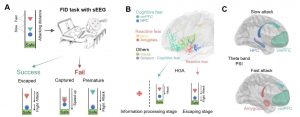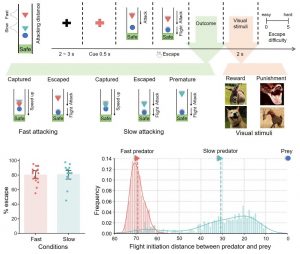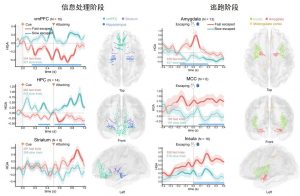A research team led by Wu Haiyan, assistant professor in the Centre for Cognitive and Brain Sciences (CCBS) at the University of Macau (UM), investigated the neural mechanisms underlying human escape behaviour using intracranial electrophysiological signals. They discovered that the cognitive fear circuit encodes the level of perceived threat during the information processing stage, while the reactive fear circuit is predominantly activated during the escaping stage. The research findings have been published in the internationally renowned journal Nature Communications.
Escape is a crucial defensive behaviour exhibited by both animals and humans when under attack. This behaviour involves several stages: first, the prey perceives and processes threat-related information (the information processing stage); then, it determines the optimal time to escape (the escaping stage). In recent years, scientists have used functional magnetic resonance imaging (fMRI) and electroencephalography (EEG) to investigate the neural mechanisms underlying escape behaviour in humans and animals. Previous research has identified two fear circuits that are activated during escape behaviour: the reactive fear circuit and the cognitive fear circuit. However, the specific roles of these circuits during the different stages of escape behaviour remain unclear. Moreover, the interaction between the reactive and cognitive fear circuits remains unexplored. To address these gaps, Prof Wu’s team collected intracranial EEG data from epilepsy patients performing an escape task to examine the role of different neural circuits in the various stages of escape behaviour.
In the study, the research team used a flight initiation distance (FID) task. In this task, participants were asked to imagine themselves as prey and needed to escape from a virtual predator. Two types of predator with varying levels of urgency, fast-attacking and slow-attacking, were introduced. Fast-attacking predators initiated their attacks earlier, requiring participants to make quick decisions about how to escape. In contrast, slow-attacking predators delayed their attacks, giving participants more time and a larger buffer zone to escape. The team then analysed high gamma band activity (HGA) in six brain regions of the participants while they performed the FID task to assess local neuronal population activity within the brain regions involved in the entire escape process. They compared participants’ neural activity when facing different types of attack to elucidate the neural activation patterns in humans under different types of attack.
At the behavioural level, the study found that participants chose to escape earlier when facing a fast attack, but delayed their escape when facing a slow attack. At the neural level, brain regions within the cognitive fear circuit, including the ventromedial prefrontal cortex (vmPFC) and the hippocampus, encoded threat levels during the information processing stage. In contrast, the reactive fear circuit, which involves the midcingulate cortex and amygdala, was prominently activated during the escaping stage, particularly in the case of a rapid attack. Notably, the team observed significant theta-band information flow from the amygdala to the vmPFC during rapid attacks, indicating dynamic communication between the reactive and cognitive fear circuits. This interaction may enable humans to make rapid responses to imminent threats, which is crucial for survival. These findings clarify the distinct yet complementary roles of the reactive and cognitive fear circuits in facilitating successful escape behaviour. This discovery contributes to a deeper understanding of the neural mechanisms by which humans respond to different types of attacks, and provides potential targets for improving decision-making abilities under threat through neural regulation.
The co-corresponding authors of the study are Prof Wu and Yao Yi, chief physician at Xiamen Humanity Hospital. The first three authors are CCBC doctoral student Zhang Haoming, former research assistant Cheng Jiayu, and doctoral student Hu Keyu. Wang Fengpeng, deputy chief physician at Xiamen Humanity Hospital; Qi Song, research fellow at the National Institute of Mental Health (US); Liu Quanying, associate professor at Southern University of Science and Technology; and Dean Mobbs, professor at the California Institute of Technology, are the co-authors. The research project was funded by the Science and Technology Development Fund of the Macao SAR (File Nos.: 0127/2020/A3, 0041/2022/A), the Shenzhen-Hong Kong-Macao Science and Technology Innovation Project (Category C) (File No.: SGDX2020110309280100), the Natural Science Foundation of Guangdong Province (File No.: 2021A1515012509), and the University of Macau (File Nos.: SRG2020-00027-ICI, MYRG2022-00188-ICI). The full version of the research article is available at: https://doi.org/10.1038/s41467-025-60666-9.
| Source: Institute of Collaborative Innovation | |
| Media Contact Information: | |
| Communications Office, University of Macau | |
| Albee Lei | Tel: (853) 8822 8004 |
| Bell Leong | Tel: (853) 8822 8009 |
| Email: | prs.media@um.edu.mo |

(A) The experimental paradigm; (B) The two circuits are involved in different stages of escape; (C) The correlation between different brain regions and types of attack

The structure of the experimental paradigm, behavioural results, and SEEG electrode recording sites

The cognitive fear circuit encodes threat levels during information processing, while the reactive fear circuit is prominently activated during escape
